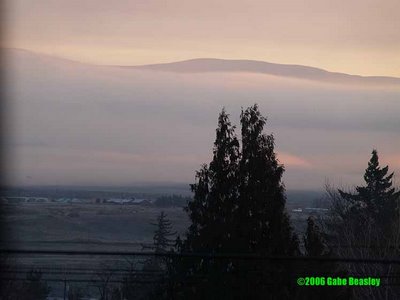
SUNRISE in The Dalles. The sun comes up at new angles every week as it is easy to notice. Both sunrise and sunset here can be beautiful off the Washington mountains and ridges. They are seen here covered in a low fog. The hard to catch rainbow below shows the same ridge-lines as are in this picture with a different lens. Both these shots were done with my new digital SLR. A wide angle lens is definitely something you want to get if your going to get a digital SLR. Most kits or lenses are all purpose an include lenses that can be used for this kind of picture as going to the old 35mm equiv. 50mm lens format.
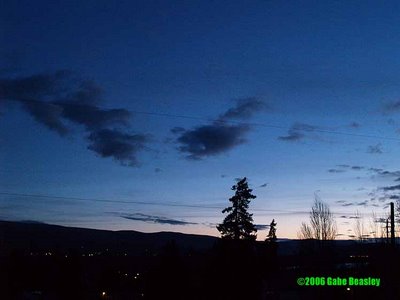 The sunrise so fast over the hills that I have to almost run to get my camera gear I forgot for this shot shot.
The sunrise so fast over the hills that I have to almost run to get my camera gear I forgot for this shot shot.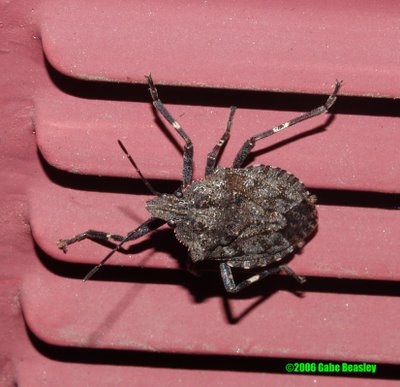 Many very interesting insects have come to my lights, this is one of many which can be found through the Northwest.
Many very interesting insects have come to my lights, this is one of many which can be found through the Northwest.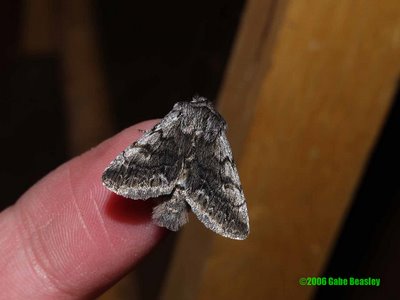 Here is a moth that was so cold it did not care as I picked it up and stick to my finger. Had it been warm this moth would not even have gotten near me. In "insect hypothermia" it does not care and the warmth of my finger might have been desired. Eventually I had to force it off my finger--even moving around quickly to try to scare it did not work. It was not harmed in release. One way of getting bugs off of you without hurting them is very simple-- blow air at them with your mouth quickly! As if blowing out a candle. The blast of air will scare off and usually just blast the spider or insect off of you without damage. It may take a few tries but it works. I've done that since I was a kid--it works very good for ants and other insects that are very hard to touch without killing or harming them.
Here is a moth that was so cold it did not care as I picked it up and stick to my finger. Had it been warm this moth would not even have gotten near me. In "insect hypothermia" it does not care and the warmth of my finger might have been desired. Eventually I had to force it off my finger--even moving around quickly to try to scare it did not work. It was not harmed in release. One way of getting bugs off of you without hurting them is very simple-- blow air at them with your mouth quickly! As if blowing out a candle. The blast of air will scare off and usually just blast the spider or insect off of you without damage. It may take a few tries but it works. I've done that since I was a kid--it works very good for ants and other insects that are very hard to touch without killing or harming them.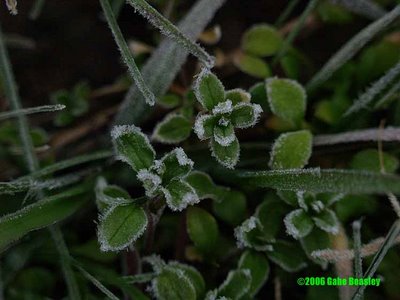 Some more pictures from the frozen ground here in The Dalles. These plants are propping up everywhere. I don't know what they are but I've gotten some interesting shots of them and other backyard stuff I just let grow.
Some more pictures from the frozen ground here in The Dalles. These plants are propping up everywhere. I don't know what they are but I've gotten some interesting shots of them and other backyard stuff I just let grow.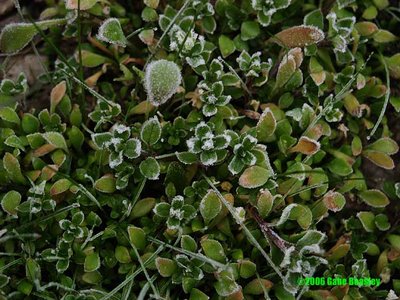
A FEW WORDS ON ISO AND F-STOP--(amended oct. 2011)
Many kinds of plants are frozen--making macro and super macro shots very good. A digital SLR that can shoot fast pictures well (above 800) is a good idea for early morning shots. Flash only becomes useful when you need to supplement natural light so turn your flash down to compensate or your picture will be washed out dark or bright. Not even Photoshop will be able to fix such a picture. This shot could be done at 200iso but you need to adjust your f-stop for a good depth of field. The higher the number-- the higher depth of field. Meaning that more of the picture will be in focus. Depth of field is the area where your camera is in good or perfect focus. The human eye does this all for us automatically. When we are using a camera in order to get good pictures you have to learn how to adjust this for the results you want. This becomes even more critical in macro shots since a low ISO will lead to very shallow depths of field. (an insect will be in focus only in a very small area) There is no way to do it automatically if you want specific results. For example--if you want to see a object that is very close to the camera such a flower, and then the ground along with the flower you need a high F-stop and almost certainly also a flash or long exposure. The higher the f-stop the more light is required for the shot. F22 or so may let you show a flower and the ground in good focus at the same time. F4 or so will leave the ground or the flower almost totally out of focus. Just experment with your f-stop control until you understand how this process works. If you want really use f stop to effect your pictures you should invest in a true SLR. A DSLR will give you many options and higher settings then a cheaper point and shoot or super-zoom camera. ISO is also important but keeping it lower will make sure your picture has low noise and turns out well. Most modern digital cameras operate well even above 3200iso -- but if you want a really great shot keep your iso lower on purpose and make sure your high ISO noise filters are ON. I usually shoot no higher then 1600 and like to keep my ISO below 800. Most of my shots are done at about 200. Most of my macro shots are done from F8 up to F40 at 200iso. At about F64 an interesting thing happens--everything becomes in focus. In fact a camera with this small an aperture does not even require a focus. Most standard SLR lenses max out between F22 and F40 or so. Even if your hand is in front of the cameras view, you will also see the background in very good focus. The tradeoff to this is that a truly HUGE amount of light is required for just a shot. The brightest sunny day is not enough unless your using impractical ISO settings. So a long exposure will be needed to get the shot. Few lenses can go to F64, you will probably have to buy a special one to get there (Very expensive!). F stop is effectively an iris or aperture that closes to smaller and smaller sizes based on what you set it for. At F22 it's almost too small to fit a pin through. At F2.8 you could fit your finger through the aperture. A functional understanding of F stop and ISO is extremely important for doing any serious photography.
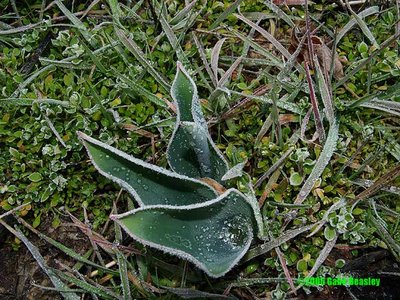 A strange plant I've photographed but I don't know what it is.
A strange plant I've photographed but I don't know what it is.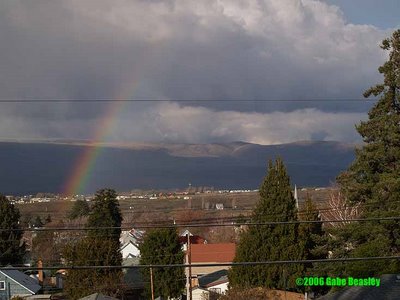 This is the picture that shows you the rainbow from my position in one of the old roads here in The Dalles. The rainbow was amazing and I got many more shots. What was interesting is that it was sun and rain in this small area at the same time. These conditions make for great weather shots. Several commercial rain protectors are sold for cameras and some DSLRs are water resistant. If I really wanted to get into storm photography I would probably get a full waterproof housing for my camera. This protects your investment very well.
This is the picture that shows you the rainbow from my position in one of the old roads here in The Dalles. The rainbow was amazing and I got many more shots. What was interesting is that it was sun and rain in this small area at the same time. These conditions make for great weather shots. Several commercial rain protectors are sold for cameras and some DSLRs are water resistant. If I really wanted to get into storm photography I would probably get a full waterproof housing for my camera. This protects your investment very well.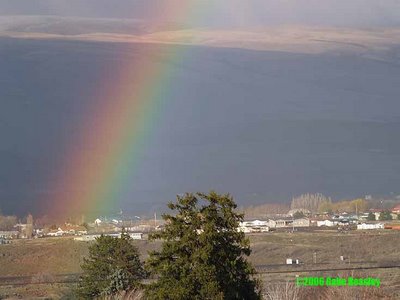 I know I've put Rainbows up before, the appear here often in The Dalles, sometimes stunningly close. I shot this with a long-lens, but the shot above this one was nearly an eye to camera perfect perspective. We had a warm period last month that looked like spring. Wrong. Many plants were hit with temperatures as bad as the depths of winter this morning.
I know I've put Rainbows up before, the appear here often in The Dalles, sometimes stunningly close. I shot this with a long-lens, but the shot above this one was nearly an eye to camera perfect perspective. We had a warm period last month that looked like spring. Wrong. Many plants were hit with temperatures as bad as the depths of winter this morning.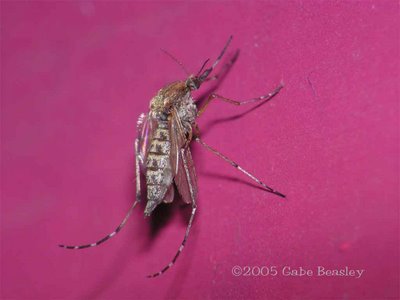 OUTDATED PICTURES -- HOW LONG WILL DIGITAL PICTURES LAST?
OUTDATED PICTURES -- HOW LONG WILL DIGITAL PICTURES LAST?(Article re-edited oct. 2011)
If your like me, you have a full hard drive and or a huge stack of CDs full of pictures but yet you keep taking them. Forgetting some of the nice shots. Printing them is nice but the prints are not perfect and will fade eventually. Sometimes I enjoy Photoshop cleanups-but getting them ready for the internet is a lot of "homework" that I don't like to do. When even the smallest articles are done, it takes me at least 1 hour per picture on this site of work. For every picture on this site there is at least an hour of work I spent on getting it ready, writing whatever I did, and waiting for computer issues. An hour of work per picture. This is not a smartphone with a "post it button". I want my pictures to look right and I have to put my name on them as well as make them small enough. Over time, good shots can get buried very quickly and can be lost if you don't organize fast and as soon as you upload your pictures from your camera. Due to the large size of my shots now, I use external hard drives to backup my pictures only. They are very hearty and are more easy then DVD backups. It is a good idea to do both but I found it a costly difficulty. I worry in any case however about technology becoming obsolete so keeping them on a hard drive can be a good idea as you can keep them up to date by transferring them on the latest drives that you get. I fear that 90% of digital pictures taken these days will be destroyed or lost on outdated media. Unlike negatives which can always be re-printed, digital 'negatives' such as RAW and JPEG files may quickly get lost on outdated media and be nearly impossible to access. If lost in an attic or something, in 100 years will you be able to find any way to print or see them again? Or just 20 years? With technology moving so fast--I fear many photos will be lost forever. Even if they survive on a CD or drive the cost may be too high or it may not even be piratical to access digital pictures that don't get moved on to the latest storage media. This is one reason I was very resistant to digital photography at first. To say nothing of disasters both man made and not.
HOW WILL DIGITAL PHOTOS SURVIVE?
By the time old digital photos are found they may be as hard to get at as data on an old huge floppy disk is to get at now or worse. One reason why I still shoot many family pictures in film. Negatives can last 100s of years or longer if taken care of. There is no such digital equivalent to this kind of hard copy. Most people never think about that but it is really worth considering. Year after year thus using external hard drives is probably a better and far more easy-- even cheaper option then berrying them in huge collections of CDs or DVDs that could take months to upgrade when CD/DVD tech is being phased out. Remember VHS? Batamax? The 8-track? It is nearly impossible for me to find a picture in a large database of 1000s of DVDs. Also, DVDs can be damaged and only have confirmed life spans of less then a decade! Everything from sunlight to mold can destroy them. I take A LOT of pictures--1000s of gigabytes of them!--but only a small number of them get published into website at a time. The pictures on this site are NOT necessarily my best pictures either. I just post the one's I want to. If you have your photo library on hard drives then it will be VERY much faster to find and go through your pictures. If your like me, you will get many drives and do double backups when ever possible so that if one drive fails you don't loose all.
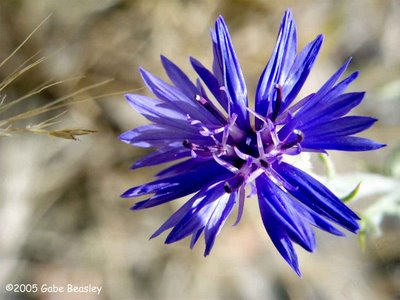 This wildflower I shot last year. There are many interesting kinds of wildflowers out here. I don't know a thing about flowers or gardening--am amazed at all forms of nature and what I can find with my macro lenses. Will spring ever arrive this year?--if it does not, I have a very large number of pictures just like these that were not published and got buried in archives. As I said--my blog is not my "best pictures" and sometimes it's a bit random.
This wildflower I shot last year. There are many interesting kinds of wildflowers out here. I don't know a thing about flowers or gardening--am amazed at all forms of nature and what I can find with my macro lenses. Will spring ever arrive this year?--if it does not, I have a very large number of pictures just like these that were not published and got buried in archives. As I said--my blog is not my "best pictures" and sometimes it's a bit random.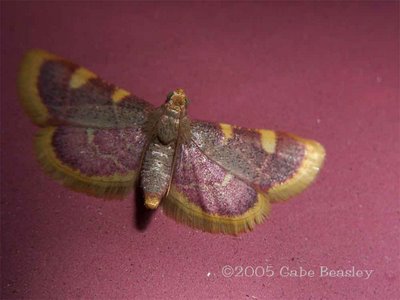 This is a very small moth I have yet to identify. It's only about 2cm at most from wing tip to wing-tip. The body is less then 1cm long. I have countless moths I have yet to publish here.
This is a very small moth I have yet to identify. It's only about 2cm at most from wing tip to wing-tip. The body is less then 1cm long. I have countless moths I have yet to publish here.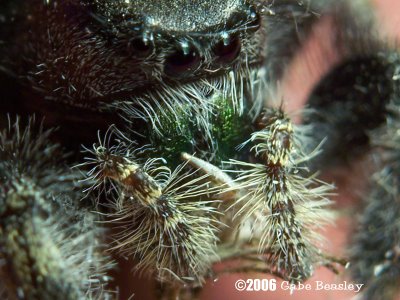 Today was looking like the first real sunny day we have had here in what seems like weeks but it's now overcast. And cold. I love winter-and prefer cold to hot many times over. White winters and lots of cloths don't bother me, I'd rather have that then a muggy island averaging at 100 degrees Fahrenheit! Most insects are not out there yet, and even less spiders. Because of this bizarre long winter--it will be interesting to see what spiders are most common after this spring. I took this shot last year as well. The copyright is not right. When you make as many pictures as I do it's amazing I don't have more mistakes. Steve from Steve's spider pics (there is a link to his site on the sidebar of mine) reminded me of some of my jumping spider pictures that might have never been published for whatever reason. So I found a few out of the huge database I don't think I have posted before. Steve's been doing very good with jumping spiders and has an impressive macro lens as well as a place where there are live jumping spiders! They are all hiding or in egg sacks still here. Someday soon they will come back.
Today was looking like the first real sunny day we have had here in what seems like weeks but it's now overcast. And cold. I love winter-and prefer cold to hot many times over. White winters and lots of cloths don't bother me, I'd rather have that then a muggy island averaging at 100 degrees Fahrenheit! Most insects are not out there yet, and even less spiders. Because of this bizarre long winter--it will be interesting to see what spiders are most common after this spring. I took this shot last year as well. The copyright is not right. When you make as many pictures as I do it's amazing I don't have more mistakes. Steve from Steve's spider pics (there is a link to his site on the sidebar of mine) reminded me of some of my jumping spider pictures that might have never been published for whatever reason. So I found a few out of the huge database I don't think I have posted before. Steve's been doing very good with jumping spiders and has an impressive macro lens as well as a place where there are live jumping spiders! They are all hiding or in egg sacks still here. Someday soon they will come back.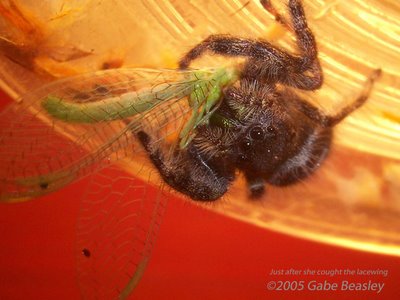 This jumping spider used to be my favorite last year, I have dozens of photographs of her. She lived above my door and caught insects for her whole life in a little hole up there she had made over my outside light. She was immortalized when I got video of her catching this very lacewing and also shot stills with my DX7630. I can almost say that this spider got used to me being around and taking her pictures. She sure did change when I caught her and released her. Jumping spiders are one of the few species of spiders that have eyes capable of identifying human beings from threatening creatures (so I have read) --I have many pictures of her. I have caught her once, and I don't think it's going too far to say that spiders can get an impression of the fact that human beings are not going to kill them. It's a theory--I know. I really noticed changes in her behavior after hours of trying to get pictures while she still ran away as soon as I approached. She seemed to eventually understand my camera and me were not going to hurt her. Spiders do learn certain things--real scientific experiments done prove that.
This jumping spider used to be my favorite last year, I have dozens of photographs of her. She lived above my door and caught insects for her whole life in a little hole up there she had made over my outside light. She was immortalized when I got video of her catching this very lacewing and also shot stills with my DX7630. I can almost say that this spider got used to me being around and taking her pictures. She sure did change when I caught her and released her. Jumping spiders are one of the few species of spiders that have eyes capable of identifying human beings from threatening creatures (so I have read) --I have many pictures of her. I have caught her once, and I don't think it's going too far to say that spiders can get an impression of the fact that human beings are not going to kill them. It's a theory--I know. I really noticed changes in her behavior after hours of trying to get pictures while she still ran away as soon as I approached. She seemed to eventually understand my camera and me were not going to hurt her. Spiders do learn certain things--real scientific experiments done prove that.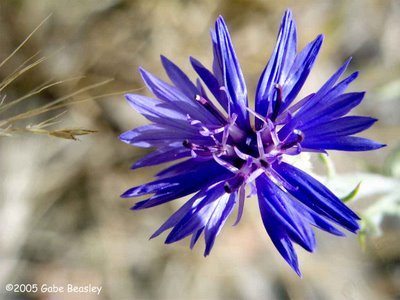 Whenever the spring happens here, there will certainly be more tiny wildflowers. In my picture sales they are a hit. It takes serious macro gear to shoot some of these flowers, this one was simple and not that small. I've got at least a thousand more pictures I could put up here on
Whenever the spring happens here, there will certainly be more tiny wildflowers. In my picture sales they are a hit. It takes serious macro gear to shoot some of these flowers, this one was simple and not that small. I've got at least a thousand more pictures I could put up here onmy site that just got forgotten in a new series of pictures or buried. I need to go back to my archives every now and then and insure that I keep them in mind--especially on days like we have been having here. All these shots were taken last year with my Kodak DX7630 before I got my new digital SLR. Coming this summer I'm going to take more shots like these if I can find a way to get to the spots.
1 comment:
Appreeciate this blog post
Post a Comment